Development of the historic heart of China
Development of the Wei basin is actively pursued under the early Han and, particularly under the long reign of the grand Emperor Wudi (141 to 87 BC). This is the region of the capital Chang’an (Figure 8.8). Major extensions to the Zhengguo canal are made in 111 BC, then again in 95 BC. The marshy nature of much of the land led to the development of a special technology for digging a canal deep into very unstable soil. This is the technique called canals with wells. The first of such works is the canal of the dragon s head. Let us listen again to Sima Qian:
“The emperor called up a labour force of over 10,000 men and set them to work digging a canal leading off from the Luo River at Zheng and extending to the foot of Mt Shangyan. There, however, it was found that the banks of the canal kept collapsing, so the men dug wells, some of them over forty zhang deep, at various points along the course and induced the water to flow from one well to another. Thus the water disappeared from sight at Mt Shanyang and flowed underground to the eastern side of the mountain, a distance of over ten li. This was the beginning of the so-called well-canals. In the course of the digging a dragon bone was discovered and the canal was therefore named Dragon Head Canal. It has been over ten years now since it was constructed but, although the water flows through it fairly well, the land has not yet shown much improvement.”[409]
One can wonder whether the inspiration for these “canals with wells " could not have been traced to qanats.
During this period there was apparently a shortage of grain in the historic heart of China. It was therefore necessary to bring grain from the east up the Yellow River and the Wei. It was costly and dangerous to tow boats upriver, especially through the Sanmen pass (the three gates). Two projects were undertaken to ameliorate the situation, specifically to reduce the time required for transport of grain from the plain to Chang’an. A proposal to the emperor described construction of a transport canal. Here is the argument developed in 133 BC by Zheng Dangshi, minister of agriculture of Wudi: “Up to now grain from east of the Pass has been brought to the capital by being transported up the Wei River. The operation requires six months to complete and the course is over 900 li and beset with dangerous places. Now if we were to dig a canal from the Wei River, beginning at Chang’an and following along the Southern Mountains to the Yellow River, the distance could be reduced to something over 300 li. We would have a much easier route for transporting grain, and the trip could be accomplished in three months. Moreover, the people living around the canal could utilize the water to irrigate over 10,000 qing of farmland.”[410]
The emperor gives the go-ahead for this project. An engineer named Xu Bo from the land of the Qi (in present-day Shangdong) is called upon to construct the canal, an
|
Figure 8.8 The transport and irrigation canals in the Wei basin, during the Han era, adapted from Lian Ruiju, Zheng Zhaojin, Hu Jialin (1987) and other sources. |
effort lasting three years and requiring the mobilization of 20,000 to 30,000 peasants.[411] Nonetheless, towage problems remain on the Yellow River. Therefore to further augment production in the region it is decided in 129 BC to construct a canal from the Fen to irrigate the Yellow River valley in the present-day Shanxi. Again, 20,000 to 30,000 peasants work on this project for several years; but in the end the Yellow River changes course and thus nullifies any benefit from this effort. The land, having been prepared for cultivation, must now be abandoned.







Leave a reply